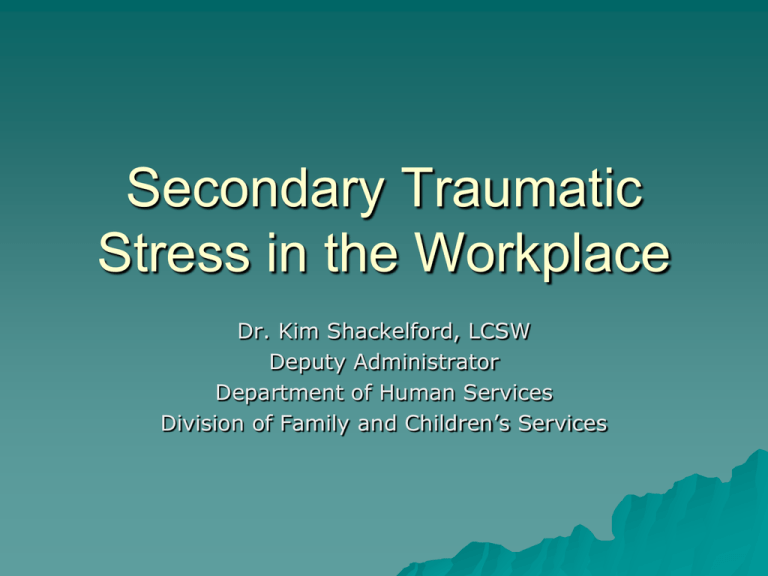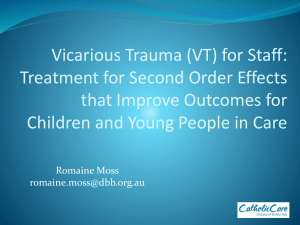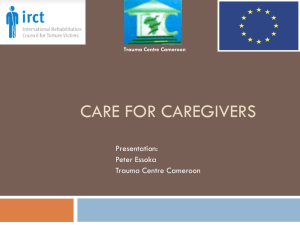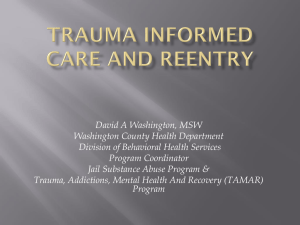File - 2014 Trauma Informed Care Conference
advertisement

Secondary Traumatic Stress in the Workplace Dr. Kim Shackelford, LCSW Deputy Administrator Department of Human Services Division of Family and Children’s Services Objectives: Participants will acquire knowledge and skills to be able to: Understand the dynamics of Post-traumatic Stress, Burnout, and Secondary Traumatic Stress Determine the relationship of traumatic stress to professionals who work with trauma victims Assess personal and professional self-care Manage direct and secondary traumatic stress Determine and identify appropriate responses to supervisees and co-workers who are experiencing traumatic stress Plan for personal and professional care/social support and management of direct and secondary traumatic stress Examine organizational response needs and provisions for helping staff manage Direct and Secondary Trauma responses What is the responsibility of professionals to prepare themselves and others for working with victims of trauma? Before…. Security Safety Equilibrium Homeostasis Normal Stress Overall – the world/life is predictable, ok, fair After… Security is threatened Safe feelings are gone Disequilibrium Abnormal stressors The world/life is not fair, predictable Nothing will ever be the same Types of Posttraumatic Stress Primary Secondary Not to be confused with Burnout Not to be confused with Countertransference Previously held beliefs… about a fair and just world are no longer valid. Literature & Theory McCann, I.L., Sakheim, D.K., & Abrahamson, D.J. (1988). Trauma and Victimization: A Model of Pyschological Adaptation. McCann, I.L. & Pearlman, L.A. (1990). Vicarious Traumatization: A Framework for Understanding the Psychological Effects of Working with Victims. Literature and Theory Figley, C.R. (1995). Compassion Fatigue: Coping with Secondary Traumatic Stress Disorder in those who Treat the Traumatized Figley, C.R. (2002). Treating Compassion Fatigue. Pryce, J., Shackelford, K., Pryce, D. (2007). Secondary Traumatic Stress and the Child Welfare Professional. Several studies called for the inclusion of information regarding the effects of indirect trauma on persons working with victims of trauma in social work education programs. (Bell, Kulkarni, & Dalton, 2003; Black, Jeffreys, & Hartley, 1993; Cunningham, 2003, 2004; Dalton, 2001; Dane, 2000; Fournier, 2002; Maidment, 2003; McCammon (1999); Morrison, 1990; Nelson-Gardell & Harris, 2003; Pryce, Shackelford, & Pryce, in press) “Those who work with the suffering suffer themselves because of the work.” C.R. Figley, 2002 Treating Compassion Fatigue Indirect Trauma Why indirect trauma? Trauma is part of our world and social workers are often there to help pick up the pieces – indirect trauma is what happens to the social worker when others face traumatic situations and social workers attempt to help them. Social Work often involves restoration of lives of persons who have been traumatized. (Bride, in press; Cunningham, 2003, Pryce, J., Shackelford, K., Pryce, D. 2007) When working with traumatized individuals, professionals can be affected… emotionally physically cognitively socially interpersonally spiritually (Bride, 2004; Bride, in press; McCann & Pearlman, 1990; Morrison, 1990; Pearlman & Saakvitne, 1995; Pryce, Shackelford, & Pryce, 2007; Valent, 1995) Effects on the Professional changes in frame of reference changes in self capacity changes in ego resources psychological needs & thought processes, safety, esteem, trust, control, intimacy, independence memory and perception change (Saakvitne & Pearlman, 1996) Effects on the clients A soul weary social worker is not able to be helpful to the client (Stamm, 1999) Compassion fatigue results in professionals leaving the field (Figley, 1995; Pryce, Shackelford, & Pryce, 2007) Impaired professionals should not continue to practice – duty to clients (NASW Code of Ethics, 1999) Saakvitne & Pearlman (1996) “self-care is an ethical imperative. We have an obligation to our clients – as well as to ourselves, our colleagues, and our loved ones – not to be damaged by the work we do.” Information has been found to be the key to mitigating the effects of indirect trauma. (Bell, Kulkarni, & Dalton, 2003) Preparation of Undergraduate Social Work Students to Cope with the Effects of Indirect Trauma Shackelford (2006) Cross-sectional survey of recently graduated BSW social workers in the United States (random selection) Recently graduated BSW students – NASW members in transition (N=192) (30% response rate) From 39 states and the District of Columbia Recently graduated BSW’s recognized burnout and posttraumatic stress disorder more often than secondary traumatic stress, compassion fatigue and vicarious traumatization Recently graduated BSW social workers do not have adequate knowledge of indirect trauma. Cross Tabulation of History of Trauma as a Child and as an Adult Trauma as Adult – No Trauma as Adult - Yes Trauma as a Child – No Trauma as a Child – Yes 34 23 26 107 Total 57 133 Out of 190 respondents who answered these questions, 130 reported childhood trauma and 26 more reported adult trauma. Study of Child Welfare Workers Pryce, Shackelford, Pryce (2007) All five states endorsed the following: Avoided thoughts and feelings Experienced traumatic events in adult life Feel trapped in my work Feel hopelessness working with clients Have been in danger working with clients Study of Child Welfare Workers Pryce, Shackelford, Pryce (2007) 4 states endorsed the following: Feel estranged from others Have difficulty falling or staying asleep Startle easily Experienced traumatic events in childhood Am preoccupied with more than one client 10 of the 17 posttraumatic stress symptoms were endorsed Building Worker Resiliency Describe the work realistically Educate at the beginning about STS Address personal traumatic stress and unresolved trauma Clarify the agencies responsibilities to the worker regarding STS as an occupational hazard Clarify worker’s responsibility for self care Give extra care to new and younger workers Management of STS increases the ability to keep hope alive for professionals and clients!








